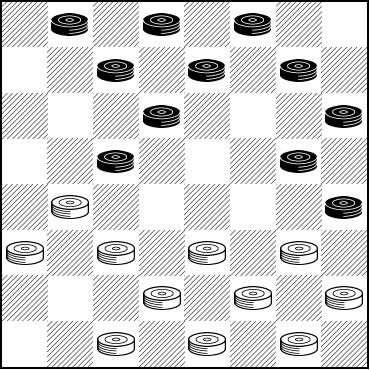We're Dunne

In our long-running Checker School series, we've featured Ben Boland's Famous Positions in the Game of Checkers. We're almost to the end of that book and this will be the last study from that source. Later, we'll move on to other positions and books of a suitably didactic nature.
It's fitting, then, to be "Dunne" with a position attributed to old-time checker great Frank Dunne.
BLACK

WHITE
White to Play and Win
W:W32,31,30,28,27,26,24,23,22,21,17:B20,16,14,12,10,8,7,6,3,2,1.
This isn't especially easy, and in Mr. Boland's notes, he points that out but is most unusually judgmental of a player who didn't find the win. In defense of the fellow that lost, this is an 11x11 position and it's easy to stray from the path.
Fortunately, The Checker Maven will never judge; we only encourage, and in this case, we urge you to find the solution. Don't stop until you're Dunne, and then click on Read More for the usual sample games and analysis.![]()
Solution
Lettered notes and unattributed commentary are by Ben Boland. Numbered notes are by the Editor using the KingsRow computer engine with 10-piece endgame database.
24-19*, 8-11, 22-18, 1-5, 18-9, 6-22---A, 26-17, 10-14---B, 17-10, 7-14, 31-26*, 3-7, 28-24*---2, 7-10, 26-22, 11-15, 22-17, 2-7---3, 30-25---C, 7-11, 25-22. White Wins---5.
Game: 9-14, 22-17, 11-16, 25-22, 8-11, 22-18, 16-20, 18-9, 5-14, 29-25, 4-8---D,1, 25-22, 11-16. Forms above position. F. Dunne, Kear's Encyclopedia, Var. 28, Page 331, 3rd Edition.
Game: 11-16, 22-18, 8-11, 25-22, 16-20, 22-17, 4-8, 30-25, 9-14, 18-9, 5-14---E, 26-22, 11-16, 24-19, 8-11, 22-18, 1-5, 18-9, 5-14, 25-22, 11-15, 29-25. Dunne’s Win. Kear's Ency. Page 105, Var. 46.
A---If 5-14, 26-22, 11-15, 30-25, 15-24, 28-19, 7-11, 17-13*, 11-15, 22-17*, 15-24, 23-19*, 16-23, 27-9, 10-15, 25-22*, 24-28, 9-5, 6-10, 5-1, 15-19, 22-18, 19-23, 1-6. White Wins.
B---11-15, 30-25, 10-14, also loses, but text forces the starred moves.
C---The late R. Atwell played 17-13---4, here against W. K. Campbell and lost by 7-11, 13-9, 14-18, 23-7, 16-23, 27-18, 5-23, etc. Thus converting a win into a loss by carelessness.
D---11-15, 25-22, 7-11, 17-13, 4-8, 22-17, 15-18*, 24-19, 18-22, 19-16, 12-19, 23-7, 2-11, 26-23, 22-25*, 23-18, 14-23, 27-18, 3-7, 17-14---F, 10-17, 21-14, 25-29, 14-9---G, 6-10, 9-6, 10-15, 6-2, 15-22, 30-25. Drawn. Sallaway vs. Kaiser, Ency. Page 329.
E---6-22, 25-18, 10-14, 18-9, 5-14, 26-22, 7-10, 22-18, 1-5, 18-9, 5-14, 29-25, 11-15---H, 25-22, 8-11, 24-19, 15-24, 28-19, 2-7, 22-18, 14-17, 21-14, 10-17, 18-14, 17-22, 23-18, 11-16, 19-15, 16-19, 14-9, 3-8. Drawn. G. Buchanan vs. J. Perrie.
F---18-14, 1-5, 30-26, 25-29, 26-23, 29-25, 23-19, 8-12, 32-27, 11-15, 13-9, 6-22, 28-24 (or 27-24), a neat draw by Dr. Schaefer.
G---18-15, 11-18, 14-9, 6-10, 9-6, also draws, Ency.
H---3-7, 25-22, 2-6, 24-19, 11-16, 27-24. J. Searight beat J. Hynd.
1---As shown in Note D, 11-15 draws. This move loses.
2---Mr. Boland stars this move but 26-22 also wins.
3---15-18 also loses.
4---This move draws, not loses, but it still misses the win.
5---5-9 17-13 and Black loses a lot of material. It's fun to watch: 14-17 21-7 9-14 15-10 and Black is down three men.
Frank Dunne in his Guide, Page 93, 1890, showed the win for the White side in an analysis on the double corner opening.
This should be noted from the Encyclopedia (Kear's): "Dunne's win is an important position brought up variously. It is easy to get into, but hard to win, and the player must be alert when it threatens or is realized. The point is to be able to go up 11-15 (at Note D)".
You can email the Webmaster with comments on this article.